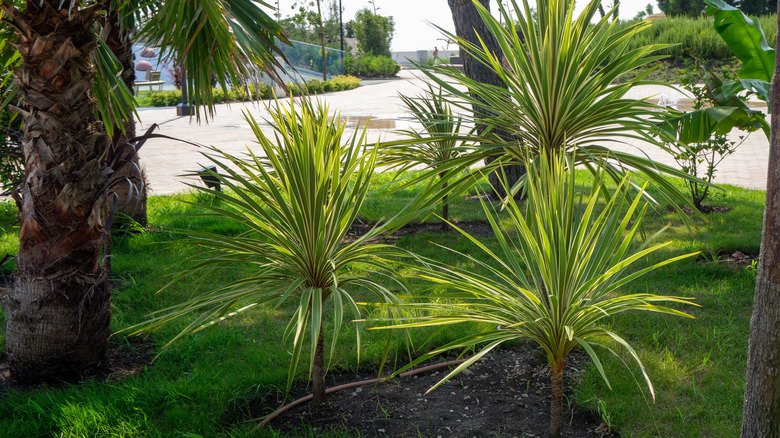The Easy-To-Grow Plant With Stunning Color In Fall & Summer That Thrives In Most Conditions
Few gardeners dislike visually beautiful plants that are undemanding of their attention. When a plant can handle heat, drought, humidity, and even poor soil without losing its vibrant flair, it quickly becomes a favorite in the garden. The 'Color Guard' yucca (Yucca filamentosa 'Color Guard') is exactly that kind of plant. Learning how to correctly grow and care for a yucca is, broadly speaking, relatively easy. The plants can handle almost any growing conditions you throw at them. 'Color Guard,' also known as Adam's needle, is no exception. It tolerates all soil types and pH levels, so long as the soil is well-draining, making it an excellent choice for gardeners looking to fill their backyard with color in the summer and fall.
This striking evergreen perennial, hardy in Zones 4 to 10, features patterned elongated foliage with a bright-yellow center framed by deep green. Although the sharp, sword-like leaves are one of the downsides of growing a yucca plant that you should consider, there is no denying the 'Color Guard' yucca's visual appeal. In the summer, tall flower spikes loaded with white blooms appear, attracting pollinators, including hummingbirds. When fall arrives and temperatures cool, the long, pointed leaves develop a pink-red hue that will keep your garden looking lively well into the winter months. Whether it's used as a focal point in a garden bed, planted in a large decorative container, or mixed with other hardy, drought-tolerant plants on a slope, the 'Color Guard' yucca proves that low-maintenance gardening doesn't have to be boring.
Growing and caring for a 'Color Guard' yucca
It's easy to see why so many gardeners add 'Color Guard' yucca to their plant collection: This tough-as-nails plant is perfect for a low- or no-maintenance garden. For one, its parent plant, Yucca filamentosa, is native to southeastern North America, making it well adapted to local climates. Although the spiky plant loves full sun, it can also handle some shade with no issues. Plant it somewhere that sees 4 to 6 hours of sun daily and it will thrive. 'Color Guard' is deer and rabbit resistant, most likely due to the sharpness of the leaves, and it is almost completely disease and pest free. If aphids become bothersome, kick them to the curb with one kitchen ingredient you already own: cayenne pepper. Check, too, for signs of leaf spot.
Watering your 'Color Guard' yucca regularly during its first year encourages it to develop deep roots. Once it is established, it is drought resistant and doesn't need much water. Only water a mature 'Color Guard' yucca when the top layers of soil around the plant are dry, and do so deeply. If the soil is moist, your plant doesn't need watering. Overwatering your yucca plant can cause root rot. Pruning involves removing the dead blooms at the end of the flowering season and trimming away damaged or dead leaves as needed. Wear gardening gloves to avoid getting stabbed by the sharp leaves. A word of warning for gardeners with pets: 'Color Guard' yucca is toxic to cats, dogs, and horses when ingested. Supervise them around this plant.

